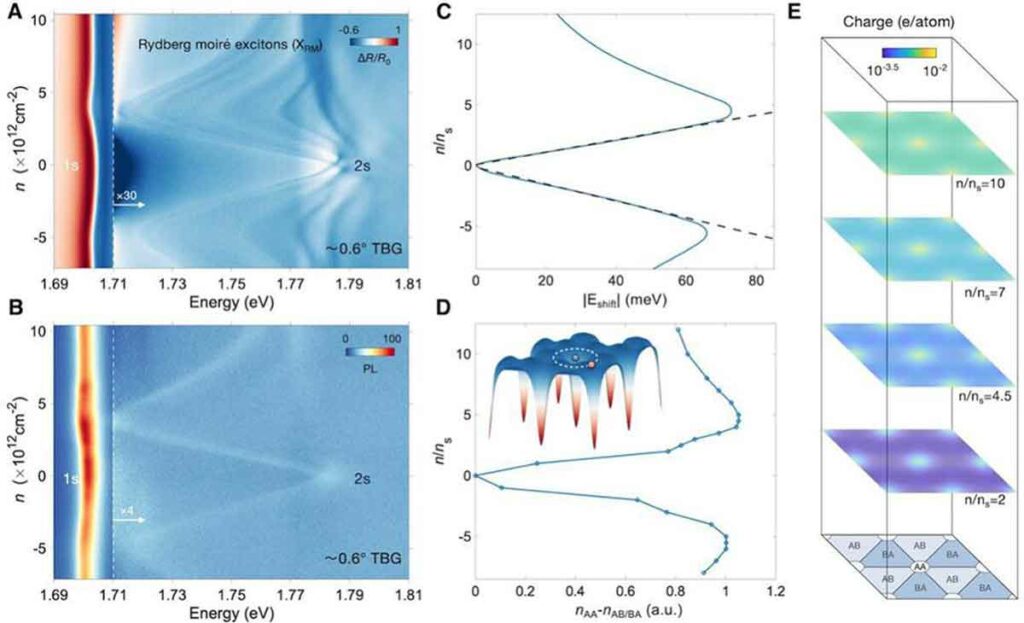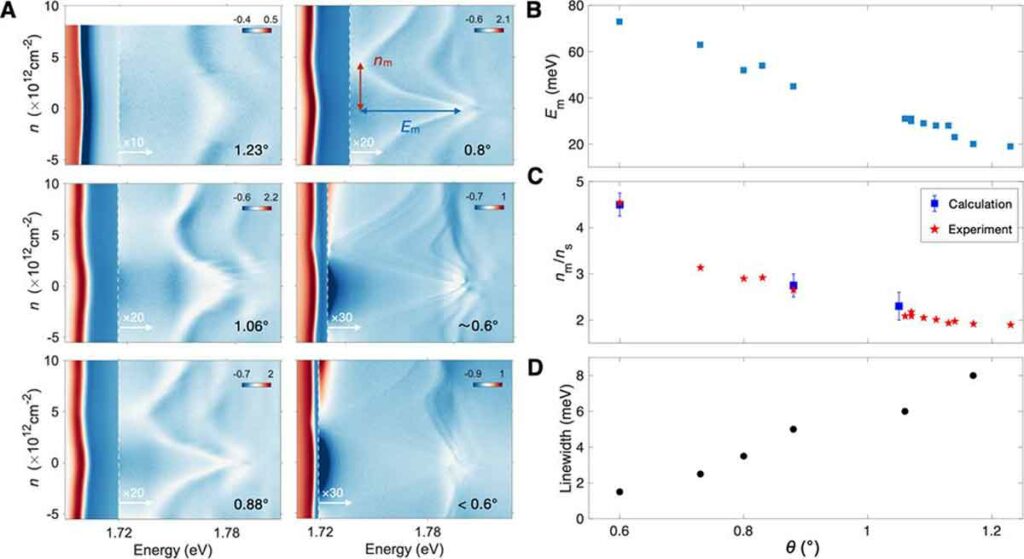In a groundbreaking study published in Science, researchers from the Institute of Physics of the Chinese Academy of Sciences (CAS) and Wuhan University have unveiled the remarkable potential of Rydberg moiré excitons in advancing quantum technologies.
The study, led by Dr. Xu Yang and Dr. Yuan Shengjun, explores the interaction of Rydberg excitons in the monolayer semiconductor WSe2 with small-angle twisted bilayer graphene (TBG).
Rydberg excitons, which are highly excited Coulomb-bound states of electron-hole pairs, have long been known to exist in various physical platforms such as atoms, molecules, and solids.
However, efficiently trapping and manipulating these excitons has posed a significant challenge for researchers.
Addressing this obstacle, Dr. Xu Yang and his collaborators turned to the emerging field of two-dimensional (2D) moiré superlattices, which offer highly tunable periodic potentials.
By leveraging the unique properties of TBG and WSe2, they sought to exploit the advantages of Rydberg excitons for sensing, quantum optics, and quantum simulation.
The team’s efforts yielded remarkable results.
Through low-temperature optical spectroscopy measurements, they observed the manifestation of Rydberg moiré excitons, characterized by multiple energy splittings, a pronounced red shift, and a narrowed linewidth in the reflectance spectra.
Exploring Rydberg Moiré Excitons
To comprehend the underlying mechanisms behind these observations, the researchers conducted numerical calculations in collaboration with the Wuhan University group.
Their analysis revealed that the spatially varying charge distribution in TBG creates a periodic potential landscape, known as moiré potential, which interacts with the Rydberg excitons.
The confinement of Rydberg excitons is achieved through unequal interlayer interactions between the constituent electron and hole, resulting from the spatially accumulated charges in the AA-stacked regions of TBG.
This confinement enables the Rydberg moiré excitons to exhibit long-lived charge-transfer characteristics, effectively separating the electron and hole.
Manipulating Rydberg Excitons with Precision
Significantly, the study introduced a novel method for manipulating Rydberg excitons, overcoming the challenges encountered in bulk semiconductors.
The researchers harnessed the properties of the long-wavelength moiré superlattice as an analog to optical lattices created by standing-wave laser beams or arrays of optical tweezers utilized in Rydberg atom trapping.
The tunable moiré wavelengths, combined with in-situ electrostatic gating and extended exciton lifetimes, offer exceptional controllability and strong light-matter interactions.
These factors facilitate convenient optical excitation and readout, enhancing the potential for coherent control of Rydberg states.
Quantum Technological Advancements on the Horizon
The implications of this study extend beyond the realm of fundamental research.
The newfound understanding of Rydberg moiré excitons opens doors to exploring Rydberg-Rydberg interactions and realizing coherent control, crucial for advancements in quantum information processing and quantum computation.
By harnessing the remarkable properties of Rydberg excitons and the tunability provided by moiré superlattices, future quantum technologies may benefit from enhanced sensing capabilities, improved quantum optics, and the development of powerful quantum simulators.
The ability to precisely manipulate and control Rydberg excitons brings us one step closer to unlocking the full potential of quantum mechanics.
As the field of quantum technology continues to evolve, further exploration of Rydberg moiré excitons promises to shape the future of computing, communication, and information processing, ushering in a new era of unprecedented possibilities.
The Potential of Rydberg Moiré Excitons Unveiled
In a recent study published in Science, researchers from the Chinese Academy of Sciences and Wuhan University have made a significant breakthrough in the field of quantum technologies.
They have discovered the potential of Rydberg moiré excitons, which are highly excited Coulomb-bound states of electron-hole pairs, for various applications in sensing, quantum optics, and quantum simulation.
Dr. Xu Yang and his colleagues have successfully observed Rydberg moiré excitons in the monolayer semiconductor WSe2, coupled with small-angle twisted bilayer graphene (TBG).
This achievement could pave the way for advancements in quantum information processing and quantum computation.
Unleashing the Power of Rydberg Excitons
Rydberg excitons have been widely studied in different physical systems, including atoms, molecules, and solids. However, effectively trapping and manipulating these excitons has been a major challenge.
Dr. Yang’s team tackled this issue by exploring the potential of two-dimensional moiré superlattices, which offer tunable periodic potentials.
Their experimental observations, combined with numerical calculations, revealed that Rydberg moiré excitons exhibit unique characteristics, such as multiple energy splittings, a pronounced red shift, and a narrowed linewidth in the reflectance spectra.
These findings are attributed to the spatially varying charge distribution in TBG, creating a moiré potential that interacts with the Rydberg excitons.
Unlocking Controllability and Precision
The researchers also demonstrated a groundbreaking method for manipulating Rydberg excitons, a feat that has been challenging to achieve in bulk semiconductors.
By leveraging the properties of the long-wavelength moiré superlattice, analogous to optical lattices, they achieved exceptional controllability and strong light-matter interactions.
Tunable moiré wavelengths, in-situ electrostatic gating, and extended exciton lifetimes contribute to precise manipulation and control.
These advancements hold great promise for coherent control of Rydberg states, opening avenues for quantum information processing and quantum computation.
Shaping the Future of Quantum Technologies
The discovery of Rydberg moiré excitons presents exciting opportunities for the field of quantum technologies.
By harnessing their unique properties and leveraging the tunability offered by moiré superlattices, researchers can develop enhanced sensing techniques, improve quantum optics, and create powerful quantum simulators.
The ability to precisely manipulate and control Rydberg excitons represents a significant step towards fully realizing the potential of quantum mechanics.
As we continue to unlock the mysteries of quantum technology, further exploration of Rydberg moiré excitons will undoubtedly shape the future of computing, communication, and information processing.
The possibilities are endless, and we are on the cusp of a new era of scientific and technological advancements.
FAQs
Rydberg moiré excitons are highly excited Coulomb-bound states of electron-hole pairs that have been observed in the monolayer semiconductor WSe2 in conjunction with small-angle twisted bilayer graphene (TBG). These excitons exhibit unique characteristics and hold great promise for various quantum applications.
Researchers have developed a novel method for manipulating Rydberg moiré excitons by leveraging the properties of the long-wavelength moiré superlattice. By utilizing tunable moiré wavelengths, in-situ electrostatic gating, and extended exciton lifetimes, precise control and manipulation of these excitons become possible.
Rydberg moiré excitons have significant potential in sensing, quantum optics, and quantum simulation. Their unique properties, combined with the tunability offered by moiré superlattices, can lead to advancements in quantum information processing and quantum computation.
Studying Rydberg moiré excitons in 2D semiconductors, such as WSe2, offers several advantages. These include the solid-state nature of Rydberg excitons, their large dipole moments, strong mutual interactions, and enhanced interactions with the surrounding environment. These advantages make them suitable for a wide range of applications.
Rydberg moiré excitons provide opportunities for advancements in quantum information processing. By enabling the manipulation and control of Rydberg states, these excitons can play a crucial role in realizing coherent control, which is essential for quantum computing and the processing of quantum information.
More information: Rydberg moiré excitons, Science (2023). DOI: 10.1126/science.adh1506



